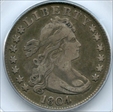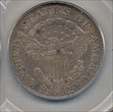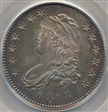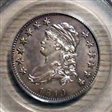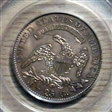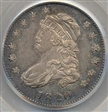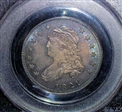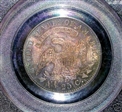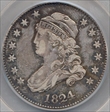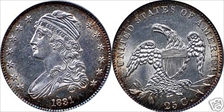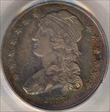rfar 的钱币相册
1818 25C MS64 PCGS. B-4, R2. Population (PCGS 45/23, NGC 72/49). The Capped Bust coinage of John Reich was initially developed in 1807, beginning with the half dollar. According to the late Walter Breen, writing in his Encyclopedia: "Reich's new conception for the silver coins was an uncommonly buxom effigy of Ms. Liberty, wearing a mobcap inscribed with her name. (This was for generations misnamed a turban by people who never saw a real one; and even from the beginning it was taken to represent the pilleus or Phrygian liberty cap, whereas Reich actually intended it as a fashionable headdress, somewhat like that on some portraits of Martha Washington. Contemporaneous newspaper scurrility attacked the device as portraying 'the artist's fat mistress.') Reich placed it first on half dollars and half eagles, fall 1807; then quarter eagles 1808, dismes 1809, and finally quarter dollars, the next time banks ordered them 1815." According to the information presented in A.W. Browning’s work on Early Quarter Dollars the total number of pieces coined were 361,174 with no less than 10 varieties known. Die State VII, which Breen considered very rare. This specimen was struck from multiply clashed dies with bold die cracks that bisect the portrait and pass through Liberty's shoulder and the D in UNITED. Aside from its dramatic die cracks, B-4 can be identified by the UNIT in UNITED, which are very close at the tops of the letters. Deep rose-gold and forest-green toning embraces this sharply struck type coin. The surfaces are clean save for a minor thin handling mark in the field near the eagle's beak.
1818 25C MS64 PCGS. B-4, R2. Population (PCGS 45/23, NGC 72/49). The Capped Bust coinage of John Reich was initially developed in 1807, beginning with the half dollar. According to the late Walter Breen, writing in his Encyclopedia: "Reich's new conception for the silver coins was an uncommonly buxom effigy of Ms. Liberty, wearing a mobcap inscribed with her name. (This was for generations misnamed a turban by people who never saw a real one; and even from the beginning it was taken to represent the pilleus or Phrygian liberty cap, whereas Reich actually intended it as a fashionable headdress, somewhat like that on some portraits of Martha Washington. Contemporaneous newspaper scurrility attacked the device as portraying 'the artist's fat mistress.') Reich placed it first on half dollars and half eagles, fall 1807; then quarter eagles 1808, dismes 1809, and finally quarter dollars, the next time banks ordered them 1815." According to the information presented in A.W. Browning’s work on Early Quarter Dollars the total number of pieces coined were 361,174 with no less than 10 varieties known. Die State VII, which Breen considered very rare. This specimen was struck from multiply clashed dies with bold die cracks that bisect the portrait and pass through Liberty's shoulder and the D in UNITED. Aside from its dramatic die cracks, B-4 can be identified by the UNIT in UNITED, which are very close at the tops of the letters. Deep rose-gold and forest-green toning embraces this sharply struck type coin. The surfaces are clean save for a minor thin handling mark in the field near the eagle's beak.
1819 25C Small 9 AU58 PCGS. B-3, R1. Population (PCGS 5/18, NGC 1/4). Die State II, Colon After 25C: The 9 in the date is mostly centered beneath Liberty's lowest hair curl. On the reverse the ED in UNITED is aligned, with the D somewhat higher. The 25 in the denomination is re-punched, the 2 lightly, the 5 broadly. A light die crack from the rim through star 11 to the bust, and a slender diagonal crack though the bust truncation and the first 1 in the date to the rim, otherwise the dies are perfect. Encapsulated in a green label holder. Both sides of this wondrously preserved example has surfaces drenched in a sea-green and pearl-gray with occasional overlays of subtle steel-blue toning draping this satiny and attractively preserved Bust Quarter. The strike is exemplary.
1819 25C Small 9 AU58 PCGS. B-3, R1. Population (PCGS 5/18, NGC 1/4). Die State II, Colon After 25C: The 9 in the date is mostly centered beneath Liberty's lowest hair curl. On the reverse the ED in UNITED is aligned, with the D somewhat higher. The 25 in the denomination is re-punched, the 2 lightly, the 5 broadly. A light die crack from the rim through star 11 to the bust, and a slender diagonal crack though the bust truncation and the first 1 in the date to the rim, otherwise the dies are perfect. Encapsulated in a green label holder. Both sides of this wondrously preserved example has surfaces drenched in a sea-green and pearl-gray with occasional overlays of subtle steel-blue toning draping this satiny and attractively preserved Bust Quarter. The strike is exemplary.
1820 25C Small O AU58 PCGS. B-4, R2. Population (PCGS 8/9, NGC 1/1). The relationship between the quarter and half dollar during this era is similar to that between the half cent and large cent. The larger denomination was preferred in commerce, and had significantly higher mintages. Aside from the 1815, the 1820 is the lowest mintage year of the Capped Bust half series. Yet its mintage of 751,122 pieces is more than five times that of the 127,444 quarters struck that year. The date has a small 8, star 7 points to the lower part of the cap, and the I in PLURIBUS is centered under the left stand of the second T in STATES. Splashes of blue, olive-green, and purple intermingle over quite clean surfaces that retain a fair amount of luster. Sharp definition is apparent on all of the design features.
1820 25C Small O AU58 PCGS. B-4, R2. Population (PCGS 8/9, NGC 1/1). The relationship between the quarter and half dollar during this era is similar to that between the half cent and large cent. The larger denomination was preferred in commerce, and had significantly higher mintages. Aside from the 1815, the 1820 is the lowest mintage year of the Capped Bust half series. Yet its mintage of 751,122 pieces is more than five times that of the 127,444 quarters struck that year. The date has a small 8, star 7 points to the lower part of the cap, and the I in PLURIBUS is centered under the left stand of the second T in STATES. Splashes of blue, olive-green, and purple intermingle over quite clean surfaces that retain a fair amount of luster. Sharp definition is apparent on all of the design features.
1821 25C MS64 PCGS. B-5, R4. Population (PCGS 13/11, NGC 20/10). The mintage reported for the year was 216,851 coins, although some of those were from dies dated 1820. It would be almost impossible to speculate how many of each date were included in the total production figure. Mintage of the Capped Bust quarter dollars was sporadic at best. The following years are represented: 1815, 1818-1825, 1827, and 1828. Breen suggested that the public much preferred the Spanish 2 Reals silver pieces and other fractional units. The Spanish colonial pieces were much more familiar to most people of the young nation. Designs were by John Reich, who redesigned all of the circulating coinage after he was hired in 1807. The quarters and half dimes were the last two denominations to adopt the new designs, in 1815 and 1829 respectively. Three obverse and five reverse dies were produced for a combination of six different die varieties. With the exception of "B-6," of which only two coins are believed extant, B-5 is the scarcest variety of the 1821 Quarter. This coin most likely qualifies for Condition Census. It has the first star near the bust truncation, while the seventh star points to the headband. The sixth star is boldly re-cut.
1821 25C MS64 PCGS. B-5, R4. Population (PCGS 13/11, NGC 20/10). The mintage reported for the year was 216,851 coins, although some of those were from dies dated 1820. It would be almost impossible to speculate how many of each date were included in the total production figure. Mintage of the Capped Bust quarter dollars was sporadic at best. The following years are represented: 1815, 1818-1825, 1827, and 1828. Breen suggested that the public much preferred the Spanish 2 Reals silver pieces and other fractional units. The Spanish colonial pieces were much more familiar to most people of the young nation. Designs were by John Reich, who redesigned all of the circulating coinage after he was hired in 1807. The quarters and half dimes were the last two denominations to adopt the new designs, in 1815 and 1829 respectively. Three obverse and five reverse dies were produced for a combination of six different die varieties. With the exception of "B-6," of which only two coins are believed extant, B-5 is the scarcest variety of the 1821 Quarter. This coin most likely qualifies for Condition Census. It has the first star near the bust truncation, while the seventh star points to the headband. The sixth star is boldly re-cut.
1832 25C MS62 PCGS. B-2, R2. Population (PCGS 14/23, NGC 9/24). This is a scarce issue, with 320,000 reported struck, many of these being coins of the previous year now being shipped from the mint. This date is found far less often than an 1831 or 1834 and is, in fact, the second scarcest of this nine-year series. The small arrowheads identify the Browning-2 variety, which is somewhat scarcer than the only other die pairing of the date, B-1. The low PCGS population includes both marriages. Beautiful sea-green, russet, and pearl-gray colors enrich this meticulously struck and lightly marked representative. The mint luster is especially intense on the reverse.
1832 25C MS62 PCGS. B-2, R2. Population (PCGS 14/23, NGC 9/24). This is a scarce issue, with 320,000 reported struck, many of these being coins of the previous year now being shipped from the mint. This date is found far less often than an 1831 or 1834 and is, in fact, the second scarcest of this nine-year series. The small arrowheads identify the Browning-2 variety, which is somewhat scarcer than the only other die pairing of the date, B-1. The low PCGS population includes both marriages. Beautiful sea-green, russet, and pearl-gray colors enrich this meticulously struck and lightly marked representative. The mint luster is especially intense on the reverse.
Originally in the Dayers collection. Purchased from R. Uhrich at the Baltimore Coin Convention in '10.
Originally in the Dayers collection. Purchased from R. Uhrich at the Baltimore Coin Convention in '10.




















